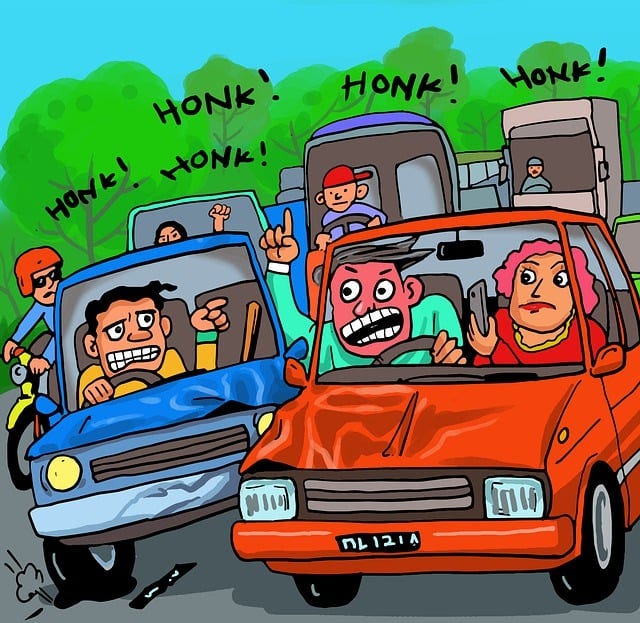Road Rage, A Dangerous Epidemic
Many problems have caused people to become easily angry and grateful while driving.
Road Rage, A Dangerous Epidemic
Researchers say road rage and road rage shootings have increased in recent years. According to various reports, the average number of people shot and killed or wounded in road rage incidents in the United States has doubled. The increase in road rage incidents is attributed to several factors, such as the availability of guns. However, many studies show that the Covid Pandemic created severe problems for many families, including unemployment, inflation, and shortage of cash to spend on vitally essential items such as food and the long period having to keep the family isolated at home to prevent the spread of the deadly virus.
It’s a familiar scene. A husband gets into an argument with his wife at the start of the day, or the husband arrives at work late. The boss gives him a warning, or on the way to work or back home, and there is a traffic jam that tries his patience. He sits in the car and fumes with frustrated anger. He could quickly explode if just one more thing happened. Then, one more thing happens when another car weaves in and out of lanes, cutting right in front of him. He then explodes into rage. He sticks him out of the car window and gives the other driver the cursed finger. Both drivers get out of their cars in the middle of the traffic jam, and the fight begins. The scenario is one example of road rage. If either driver has a gun, there could be a fatality.
Too often, road rage can have dire consequences. An angry confrontation can be highly embarrassing if family and friends are in the car. Another scenario is that anger leads to careless driving, resulting in deadly traffic accidents. In many states, three or more citations can lead to suspension of the driver’s license and spending an afternoon in jail. In other cases, this drama can cause a lawsuit with significant financial damages awarded to the other drivers.
How can these scenarios be prevented? One strategy for those with anger problems is to interrupt their thoughts and ask themselves two things: first, everyone must concentrate on their driving and not the other person. In addition, everyone needs to remind themselves that whatever happens on the road is not personal.
Is it worth it to get out of the car or take some other dangerous action and
What are the consequences of taking action?
If you lose control of yourself in these incidents, it’s essential to seek professional help. Learning to control one’s behavior is essential to a functioning civilization. People should not and must not give in to their impulses.
Unfortunately, suppose drivers have been drinking or using other drugs. In that case, they are impaired in their ability to control their impulses.
Road rage can occur anytime a driver uses their vehicle or some other object to threaten another person or cause them harm. I have seen examples of threatening behavior like throwing objects at another car, yelling and threatening another person, and attempting to ram another vehicle.
Experts shared several suggestions for what people can do if they find themselves in a heated situation on the road:
Understand your emotional makeup. According to experts, the more you know about yourself, the better you can control your actions. You can plan your driving time accordingly or even decide not to drive when you know you’ll probably get upset.
Expect other drivers to make mistakes. Be patient and remember that others’ mistakes may be ones you have made yourself or may make in the future.
Emotions are contagious. The other driver will often mirror your anger, further escalating the situation. But you can use the same tactic to defuse the situation. Courteous behavior can be spread among drivers just as easily as anger can.
Delay driving when upset. Emotions are temporary. Wait until your emotions have calmed before driving.
Unwind. If you become upset while driving, find a place to stop and calm yourself.
Ask someone else to drive. If you’re feeling powerful emotions.
Do not drive under the influence of alcohol or any other substance.
Even a calm individual can face another driver who is aggressive or erratic.
What to do if Confronted with an Aggressive Driver?
Refrain from responding. You don’t want to do anything that might escalate the conflict.
Remain calm and take a deep breath. It’s important not to allow yourself also to become upset.
Be tolerant. The other driver may have a bad day and need to vent.
Be polite because that may behavior may help soften everyone’s anger.
Allow enough room around your vehicle.
Stay in your vehicle because doing so protects you if the other person attempts to harm you.
Call 911 or local emergency services. Seek help from law enforcement if you need help.
Drive to a busy public place where there are witnesses. Experts state that hospitals or fire stations are good places to go.





